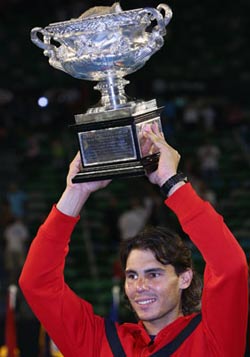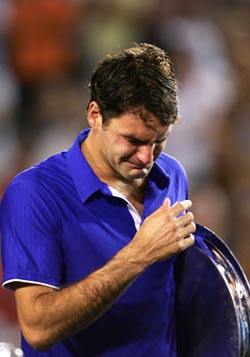|
TennisOne Lessons Rafa Rolls: A Superman for a Super SundayDavid W. Smith, Senior Editor TennisOne Missing the late-stage drama of last year’s Wimbledon final, Rafael Nadal still scintillated the Australian Open crowd (and early morning viewers here in the States and elsewhere around the world), with a super-human effort, finding a level of reserve energy that many thought would be unsustainable. Following his semi-final victory, the five-hour, fourteen minute record marathon for the Aussie Open over compatriot Fernando Verdasco, many believed Nadal would succumb to fatigue and that Roger Federer would be on his way to regaining the world’s number one ranking for 2009. Where many believed it was just a matter of time before Roger overtook Pete Sampras’ record of 14 major titles, suddenly, all eyes are on Nadal to perhaps take over that crown sooner than later.
The spectators saw Roger breakdown in tears at the trophy presentation. It was not the first time that his veneer of stoic emotional control has fractured; we saw him shed tears of joy after winning other majors. No, these were tears of possibility, in my opinion…or, perhaps impossibility; a recognition that he may not regain the title of world’s number one, and that all the hype and projection of his gaining the title of the all-time greatest player may now be in the hands—or on the racquet—of another man. While shielded from the spotlight that Federer had earned, the Spaniard Rafael Nadal has quietly won more titles and more matches than Roger Federer by the same age. Winning a major now on hard courts, a feat that seemed not in the cards only two years ago, Rafa seems poised to continue his 2008 dominance through this year as he will be the heavy favorite at Rolland Garros come May and then, perhaps a defense of his Wimbledon title in July. After that,, who knows what the U.S. Open may bring? The big question will probably not be if or when, but the ‘what if’. With such a big, physical game, can Nadal maintain his physical health? One thing that has always impressed me is the fluidity of Roger Federer’s game. The grace and rhythm, the seemingly effortless approach to hitting shots from every position has helped keep Roger from the physical breakdowns we see among so many professional tennis players today. Except for his illness from a virus early last year, one that was certainly debilitating throughout most of the season, Roger has always been relatively free of any major injury. The sheer physical prowess of Nadal would seem to suggest the possibility of sustaining some minor to major breakdown. Strength is certainly not an issue with Rafael. On the contrary, because of his strength, the connective tissue of his body might have trouble keeping up with the physical demands that his strength can summon up.
Yet, it was amazing to watch Nadal come up with the goods time and time again, even after the grueling five-plus hour match only 30 hours prior against Verdasco. Both Roger and Rafael, moved around the court with explosive and dynamic footwork. But it was Roger, who seemed to wilt in the final set, playing a loose third game, and then the errors seemed to accumulate. For once, Roger failed to mount a serious threat in the late stages of a match. But, give Nadal the credit, his perseverance, his conditioning, the constant pressure of returning shots that Fed seemingly had put out of his reach, provided a key ingredient to Nadal’s triumph. Yes, those were real tears of pain, of loss, of emotional fatigue that we saw, running down Roger’s face at the climax of the event. While the crowd tried to buoy his spirits, cheering Roger for his effort and for who he is, Federer was at odds trying to retain his composure. Who can blame him? He is human, after all. He is not immune to feelings and human fragilities, even though we have seen him as the consummate “man in control.” It reminded me of Pete Sampras breaking down when he was inducted into the Tennis Hall of Fame: A rare view of a man who, after fighting so hard to win, fighting even harder to retain self-control. In the end, it is hard not like Rafael Nadal. His own poise under pressure, his presence on the court and fighting spirit, and his likeable smile, when all is said and done, makes his victory one that all tennis players and fans alike can embrace and enjoy. I have no doubt that Roger Federer will be back. It certainly makes for an interesting 2009. And let us not forget all those other players who might very well be the dark horses who end up winning a race or two! Let’s face it; both Roger and Rafael were pushed to the limit in earlier matches. But, at the same time, it was again, Roger and Rafael who met in the final. Your comments are welcome. Let us know what you think about Dave Smith's article by emailing us here at TennisOne .
|




 Your comments are welcome. Let us know what you think about this article by
Your comments are welcome. Let us know what you think about this article by